Studio Ghibli producer makes bombshell anime revelations during online Q&A
Howl’s Moving Castle has a prequel? Why does Ghibli food look so good? Is Hayao Miyazaki a mummy’s boy? Toshio Suzuki spills all the tea.
One thing we love about Studio Ghibli is the work that goes on behind the scenes, and the ongoing bromance between two of the co-founders, producer Toshio Suzuki and director Hayao Miyazaki.
Following the sad passing of fellow co-founder Isao Takahata in 2018, the bond between Suzuki and Miyazaki has only grown stronger, and the synergy between the two is like Yin and Yang. The chatty and easygoing producer is always happy to represent the company in interviews while the more reserved director prefers to stay away from the limelight and concentrate on producing the work.
Suzuki’s strong, decades-long friendship with Miyazaki–and his working relationship as his producer–makes Suzuki the only person in the world who can reveal secrets about the director and his films without any fear of repercussions. So whenever Suzuki is scheduled to appear for an interview, Ghibli fans know to sit up and listen, and that’s what they did on Friday, when Studio Ghibli’s official Twitter account announced they would be holding a Q&A with the producer, to coincide with the television broadcast of Howl’s Moving Castle in NTV Tokyo’s “Friday Roadshow” movie slot that same evening.
The Q&A began with this image of Suzuki, holding a figurine of the Friday Roadshow character to his lips, with the message in Japanese reading: “I will answer”.
わたしがお答えします。 pic.twitter.com/I3D4zwkKf8
— スタジオジブリ STUDIO GHIBLI (@JP_GHIBLI) April 2, 2021
Answer he did, and while the discussion was focussed on Howl’s Moving Castle, other revelations came quick and fast, so let’s take a look at what was discussed below.
Q: “Why did you choose Takuya Kimura to voice the character of Howl?”
Suzuki: “It was unimaginable to have anyone but Kimura voice Howl. My daughter said he was good.”
It wasn’t just Suzuki’s daughter who thought the rich yet gentle tones of Kimura’s voice would give Howl the heart to make audiences fall in love with the character. As one of the nation’s most popular celebrities (akin to the level of celebrity Brad Pitt holds in the U.S.), Kimura’s huge fan base contributed to Howl becoming one of the studio’s most popular characters.
Q: “Do you have any anecdotes about Takuya Kimura’s dubbing session?”
Suzuki: “During recording, he talked a lot about anime. His favourite anime were Uchusen Sagittarius [a sci-fi anime that aired in Japan from 1986-1987, based on comics created by Italian physicist Andrea Romoli] and The Wonderful Adventures of Nils [an anime adaptation of the 1906 novel of the same name by Swedish author Selma Lagerlöf, which aired in Japan from 1980-1981]. He was quite the enthusiast!”Q: “What was impressive about Kimura’s voice recording?”
Suzuki: “He came to the recording studio without the script and performed it right to the end.”
This level of preparation for a role is truly impressive, and it just goes to show why Kimura remains one of the nation’s most prolific actors. It appears the role of Howl remains close to Kimura’s heart as well, as he posted this image from the televised broadcast on his official Instagram account, saying: “Thank you! Director Miyazaki is amazing, as always.”
Q: “Madame Suliman’s servants look just like Howl. Why?”
Suzuki: “The answer is hidden in the Ghibli Museum short film ‘Hoshi wo Katta Hi’.”
This is a particularly tasty bit of trivia, and one that nobody in the Twitter conversation was able to find the answer to. However, back in 2012, when Suzuki was speaking with Ghost in the Shell director Mamoru Oshii for a live broadcast, he was quoted as saying:
“In a rare move for Miyazaki, he created a side story which featured Howl in his youth. In a nutshell, a young, beautiful Witch of the Waste appeared there. In short, she took away Howl’s virginity…it became a good story.”
The side story Suzuki refers to is the 16-minute 2006 anime Hoshi wo Katta Hi (“The Day I Bought a Star“), which is shown periodically at the Ghibli Museum as one of their exclusive shorts. Released in 2006, two years after the 2004 release of Howl’s Moving Castle, the short tells the story of a boy called Nona, who goes to live with a woman called Niinya in the countryside, where he works to sell their produce. One day, he trades his turnips for a star, in the form of a blue gem, and after planting the gem in a pot it eventually grows into a planet, complete with three orbiting moons and its own weather system.
▼ Nona’s turnips recall the magic turnip-headed scarecrow from Howl’s.
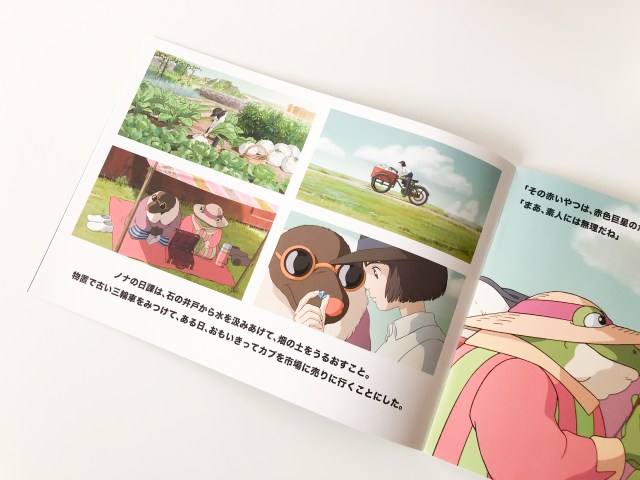
Image: SoraNews24
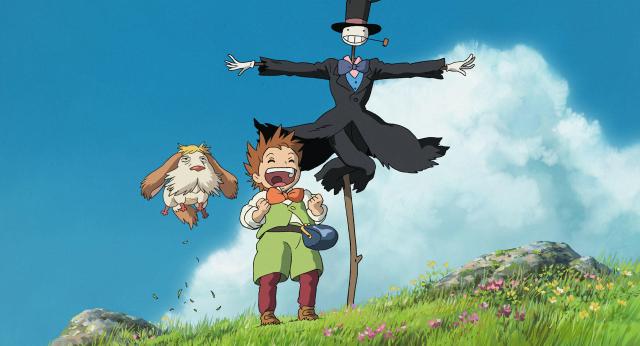
Image: Studio Ghibli
▼ And that blue gem? Howl wears one just like it around his neck in the film.

Image: Studio Ghibli
During the dramatic climax of Howl’s Moving Castle, Sophie takes a trip to Howl’s childhood, where he can be seen swallowing a star like the one below, before his heart spits out into his hands as Calcifer, the Fire Demon.
▼ Nona in The Day I Bought a Star
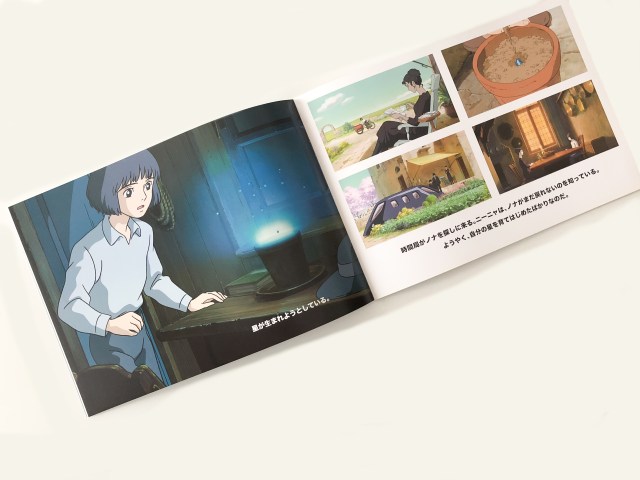
Image: SoraNews24
▼ Young Howl in Howl’s Moving Castle
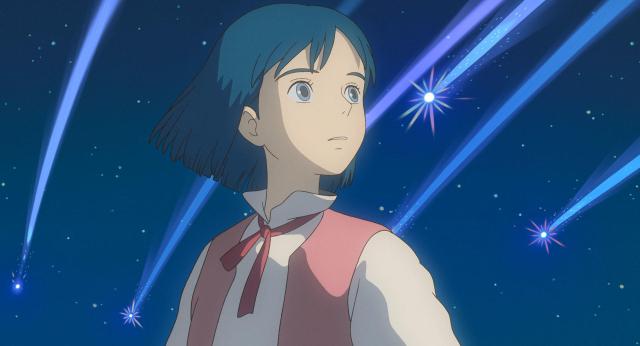
Image: Studio Ghibli
This spell, placed on him by the Witch of the Waste, is recalled in the movie on a note read out by Howl as, “He who catches a falling star, oh heartless man. Your heart shall be mine” in the English dub. This backstory between the two characters can be seen in The Day I Bought a Star, where Nona (the young Howl) eventually leaves Niinya (the young Witch of the Waste), paving the way for the tension that follows in the feature film.
Naohisa Inoue, a fantasy artist who worked on the 1995 Ghibli film Whisper of the Heart, and who came up with the initial story for The Day I Bought a Star, which he released as a picture book in 2006, addressed Suzuki’s 2012 statement with the below tweet a year later (translation follows).
@akipcs こちらこそ、ありがとうございます。鈴木さんが言ったという、ニーニャとノナ君が後の荒れ地の魔女とハウルだという説、私は宮崎駿さんから直接聞きました。あの魔女とはあんまりだ、せめてサリマン先生にしてくれと(笑)言ったんですが、イヤそうなんですとゆずられませんでした。
— Naohisa INOUE 井上直久 (@iblard_INOUE) October 11, 2013
“Suzuki saying Nona and Niinya were Howl and the Witch of the Waste is something I heard directly from Miyazaki. I laughed and said, the witch (in The Day I Harvested a Star) wasn’t that large, so I at least want Niinya to be Suliman.”
▼ Nona and a slim-looking Niinya can be seen together in the frame on the bottom right.
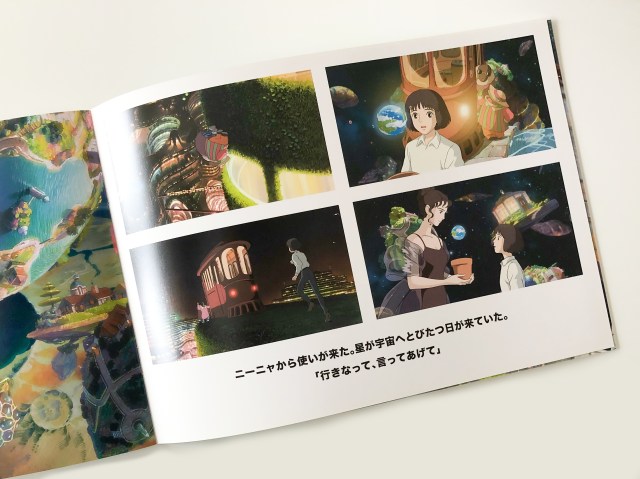
Image: SoraNews24
Inoue says he and Miyazaki first discussed the concept for The Day I Bought a Star in 2002, and while Inoue envisioned the lead as being a young girl, Miyazaki firmly believed the protagonist should be a boy. Miyazaki got his way in the end, and while there’s nothing to indicate that the woman in the story actually did take the young Howl’s virginity as Suzuki suggests–rather, she opens his eyes to his greater destiny–both witches in the feature film openly express their desire to own Howl’s heart, to such an extent that Madame Suliman even models her servants on Howl himself.
▼ Madame Suliman

Image: Studio Ghibli
That wasn’t the end of Suzuki’s revelations, however, as the Q&A continued with even more bombshell surprises.
Q: “I heard that the character of Hin was modelled on Mamoru Oshii. Is that true?
Suzuki: “That’s true. Their faces look exactly alike.” (laughs)
▼ Hin (left) Oshii (right)
サリマンの使い魔の犬「ヒン」モデルとなったのはみんな大好き押井守。
— ネコ・タカハシ (@mako_com0525) April 2, 2021
無類の犬好き。
犬になりたい監督。
ついに犬になった監督。#ハウルの動く城 pic.twitter.com/D2Aj0in3Hr
Q: “Did Miyazaki model Howl and Sophie on anyone?”
Suzuki: “Sophie was modelled on his own mother. Howl is his ideal figure.” (laughs)Q: “Why was Chieko Baisho chosen to voice Sophie?
Suzuki: “Because Miya-san [Suzuki often refers to Miyazaki as “Miya-san” in interviews] was a big fan. Even though he hides it.” (laughs)
79-year-old actress Chieko Baisho voiced both the young and old versions of Sophie in the film when she was 63 years old. Baisho started out as a singer in 1962 and became well known for playing the role of Sakura in the long-running film series Otoko wa Tsurai yo, commonly known as “Tora-San”, which ran from 1969-1995.
▼ Baisho first played the role when she was in her late 20s.
Q: “Why did Hayao Miyazaki decide to make Howl’s Moving Castle?”
Suzuki: “He wanted to take up the challenge of moving a castle that shouldn’t move.”Q: “What do you think Howl is doing right now?”
Suzuki: “Looking for a new woman again…maybe.” (laughs)Q: “Which scene was the most impressive in the making of Howl’s?”
Suzuki: “It’s the scene where Sophie and the Witch of the Waste climb the stairs. Miya-san loves that scene.”
▼ The stair-climbing scene is one of the funniest moments in the film.
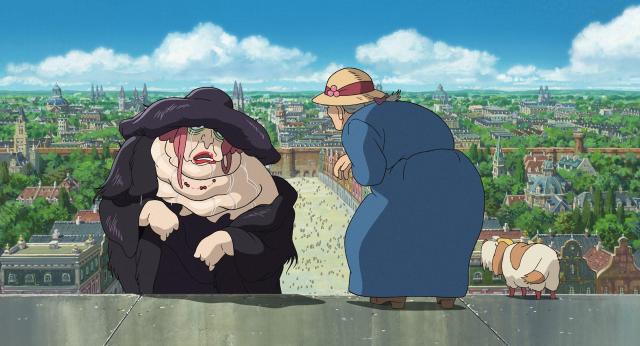 Image: Studio Ghibli
Image: Studio Ghibli
Q: “The meals that appear in Ghibli works always look delicious. Why is that?”
Suzuki: “It’s all because they’re dishes that Miya-san has actually cooked himself.”
▼ We love the idea of Miyazaki cooking up some bacon and eggs while also cooking up the idea to turn the fire beneath the pan into an animated character.
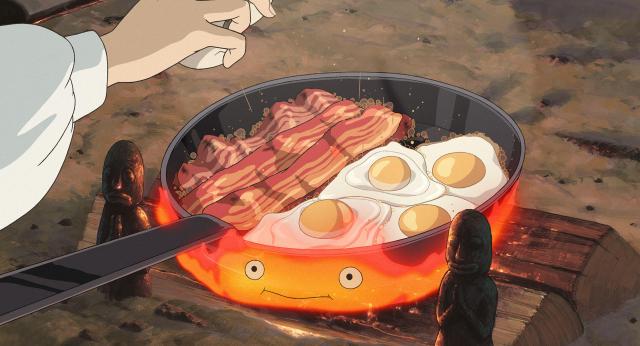
Image: Studio Ghibli
Q: “Have you ever summoned the spirits of darkness?” [Howl summons the spirits when he’s in a state of despair]
Suzuki: “I’m always summoning them because of Hayao Miyazaki. The face of the spirit resembles Hayao Miyazaki.” (laughs)Q: “I feel that the women in Hayao Miyazaki’s works are always living positively, but is the director himself attracted to this positive type of woman?”
Suzuki: “Miya-san is a mummy’s boy. The women in his works are all young Miya-san’s mother.”
As we mentioned before, only Suzuki can get away with comments like this, which is why his interviews always attract such interest. And as the Q&A session wrapped up, Suzuki treated us to two more juicy revelations.
Q: “Who is your favourite Ghibli character?”
Suzuki: “It will appear in the new work currently being produced. It’s still a secret.” (laughs)
Miyazaki’s current work-in-progress is a feature film entitled Kimi-tachi wa Dou Ikiru ka (How Will You Live?), which was said to be half-complete in December last year. In an interview that same month, Suzuki said he doesn’t expect the 125-minute long film to be complete for another three to four years. He also mentioned that another film was in development, although details for that secret project are yet to be revealed.
Before signing off from the Q&A, Suzuki had one last thing to tell the public, saying that a toy from his office was used by Miyazaki as a reference for the wreckage of Howl’s castle.
However, Miyazaki is yet to return the toy.
With that final poke at his good buddy Miyazaki, Suzuki’s Q&A came to a close, signing off with an image of Howl and the words “またね” (“mata ne”), which means “see you later”.
今週もお疲れさまでした。 pic.twitter.com/gWGQ3Et5HZ
— スタジオジブリ STUDIO GHIBLI (@JP_GHIBLI) April 2, 2021
The lively Twitter activity and thousands of likes and shares garnered by Suzuki’s humorous anecdotes prove yet again that the master producer knows how to drum up interest in Studio Ghibli.
He also knows how to satisfy everyone’s desire to know more about the studio’s legendary director, which can be a hard thing to do when Miyazaki famously likes to keep to himself, especially when he’s outside his house keeping the streets clean.
Sources: Ghibli World, Twitter/@JP_GHIBLI via Hachima Kikou
Featured image: Twitter/@JP_GHIBLI
● Want to hear about SoraNews24’s latest articles as soon as they’re published? Follow us on Facebook and Twitter!
Credit:

0 comments:
Post a Comment